Those adorable, fuzzy faces plastered with both sweetness and cunning: foxes are irresistible animals for many of us. But they’re wild and that means they’re probably not going to work for most of us. But what if you could bring home a pup that looks like a fox but had the gentleness of a domesticated pooch? Are there dogs that look like foxes?
You’re in luck! There are several dog breeds that look a lot like foxes, even some that were bred just for the purpose of looking like them. Let’s take a look!
Can Foxes Be Pets?
First, we should ask the question: can you keep a fox as a pet?
While you might find some YouTube videos featuring some lovely fox pets, they’re not a good choice for domestic pets. In most of the cases when foxes do well in someone’s family, it’s because the fox was rescued and cannot be released into the wild. They may bite when stressed, they’re difficult to train, and their wild spirits need freedom. They don’t have centuries of domestication like the dog breeds we know and love.
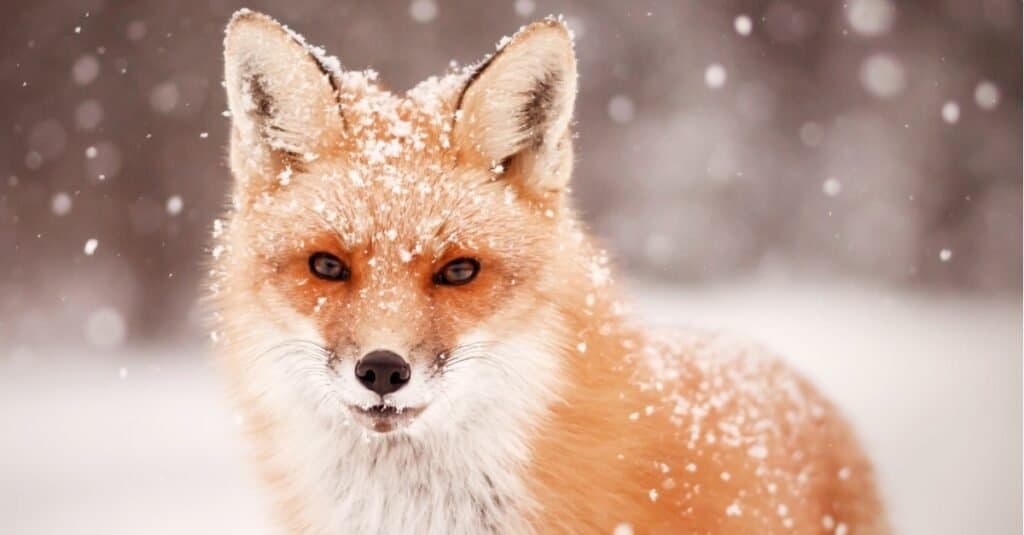
Foxes are very smart in ways that matter: finding food, surviving in weather extremes, outwitting predators, and protecting their young. They are not, however, good choices for pets.
©iStock.com/The_Near_North
Foxes are also, how shall we say it? Odorous — all the time.
All in all, these beautiful creatures should be left to experts to care for and instead, fox-like dogs should be our goal.
Dog Breeds That Look Like Foxes
Thankfully, loads of dog breeds have similar features, coloring, and personalities that vibe with their wild cousins. However, these breeds are safe to keep at home with families, unlike wild foxes.
Belgian Tervuren
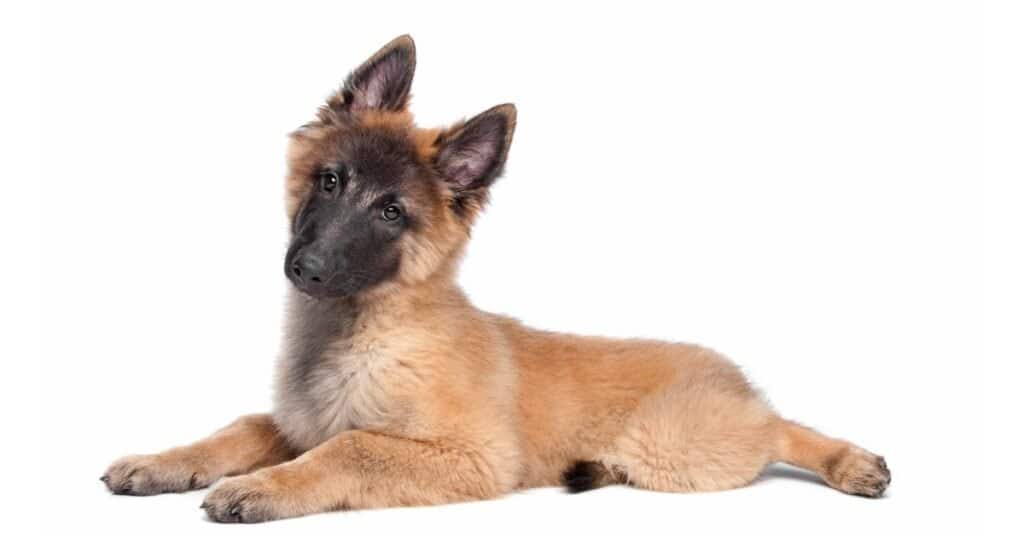
Particularly when they are young,
Belgian Tervuren
puppies look like some species of foxes.
©Erik Lam/Shutterstock.com
Originating from Belgium, the Belgian Tervuren belongs to a shepherd family from the village of the same name in Belgium. These beautiful dogs at first glance might look more like a German shepherd to some than a fox, but they’re much smaller, square-proportioned dogs. High intelligence (like those cunning foxes!), energy, and activity level make them excellent choices for fox-admirers.
In the fox world, they resemble the Silver fox, coming in fawn and russet mahogany shades to gray with black tips. Markings may include white patches on the neck, toes, and chest. They typically live between 12 and 14 years.
Icelandic Sheepdog
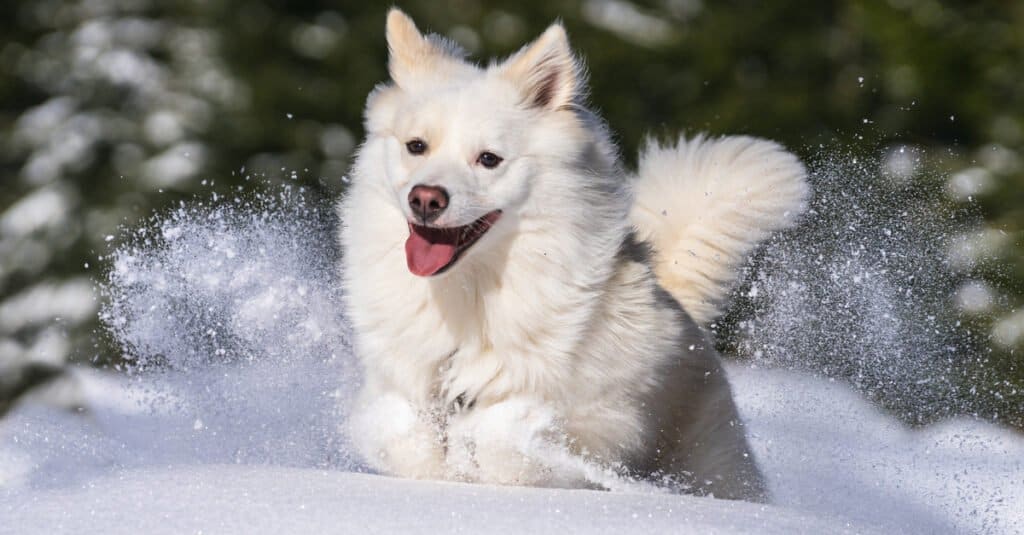
Two of the most distinctive features of the
Icelandic Sheepdog
are their bushy tails and fox-like face.
©Bildagentur Zoonar GmbH/Shutterstock.com
Originating in Iceland, as the name suggests, the Icelandic Sheepdog is a typically healthy breed of Spitz dog. Welsh corgis and Shetland sheepdogs came together in Iceland to ancestor this breed, producing a highly active, fox-like dog that needs daily exercise. They’re highly social animals and don’t do so well when left at home for long periods – they need their human companions to avoid anxiety.
Getting along well with other pets and strangers, they still need to be socialized early in life to maintain a healthy relationship with everyone. Tan patches, red fur, upward-facing triangular ears and the shapes of their faces make these fluffy dogs appear rather like the red fox. They live 12 to 15 years when healthy, hit heights of 16 inches, and typically weigh between 19 and 31 pounds.
Typical coloration includes red and white fur, but they may also come in white and cream, black and white, gold and white, chocolate and white, fawn and white, or gray and white.
American Eskimo Dog
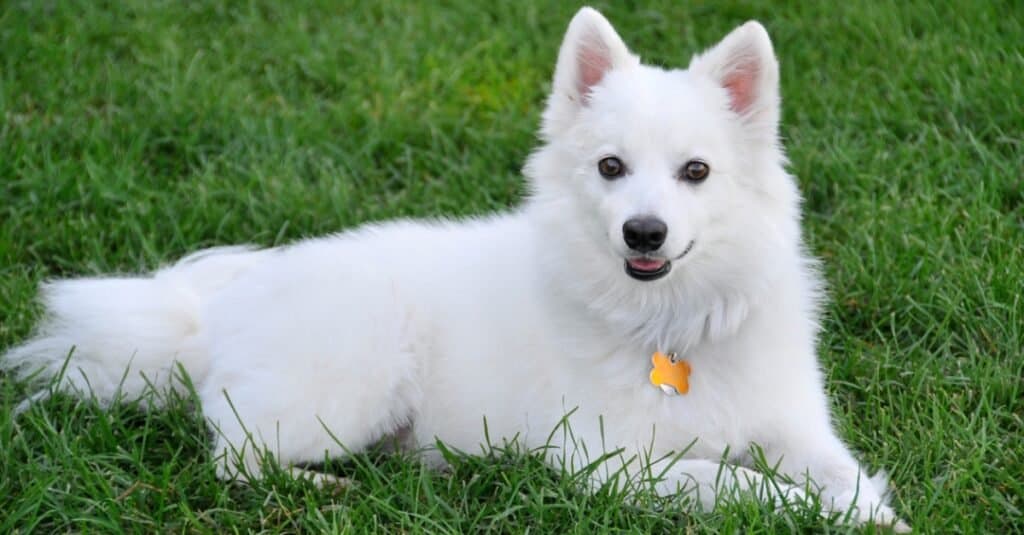
The
American Eskimo Dog
is one of many breeds of dogs that look like foxes.
©iStock.com/blendshapes
First brought to America in the 1930s, but originating in Germany, the name may be a hint surprising. The American Eskimo Dog was a circus dog in its early days, a fuzzy, adorable member of the Spitz family. High intelligence, friendliness, alertness, and protective personality traits all find home in this fox-like pooch.
Looking rather like the Artic fox, with straight, wedge-shaped ears, American Eskimo Dogs are some of the most trustworthy and child-safe breeds around. Their good looks with distinctive black points (nose, lips, and eye rims) and relatively small size make them a beautiful family favorite. American Eskimo Dogs live between 13 and 15 years and come in white. Toys weigh in between 6 and 10 pounds and 9 to 12 inches at the shoulder; minis come to 12 to 15 inches and 10 to 20 pounds, and standards between 15 and 19 inches and 25 to 35 pounds.
Volpino Italiano
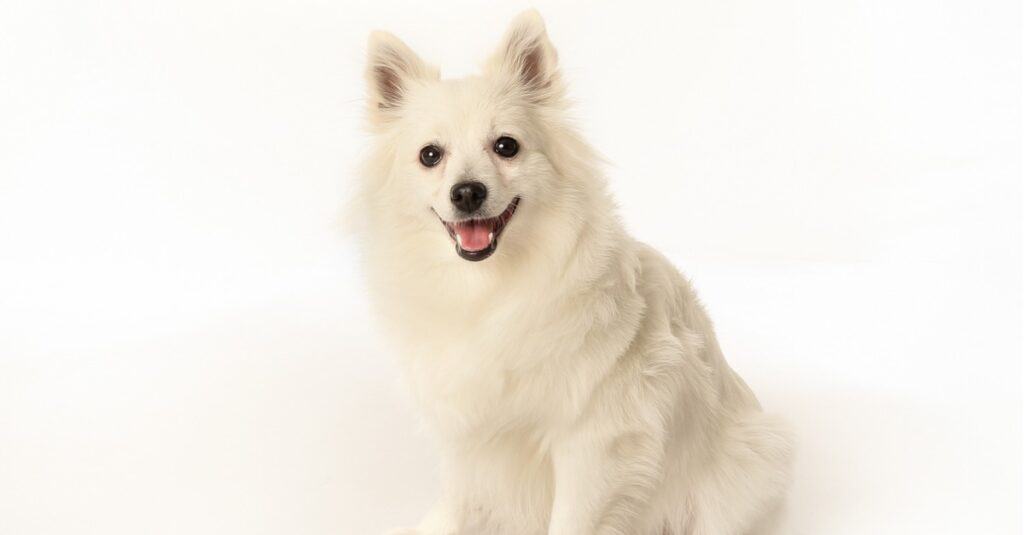
Look at that glorious fur on the volpino italiano! It’s one of the reasons they resemble foxes apart from their fox-like faces.
©iStock.com/Bigandt_Photography
As the name implies, the Volpino Italiano dog originates in Italy, a Spitz-relative. Kept initially as a guard dog to alert the larger dogs to intruders, despite its tiny size, the energetic, lively, fluffy pooch is reminiscent of an arctic fox. In 1965, the tiny dogs were near extinction, with only 5 remaining dogs alive. Efforts to revive the breed, however, kicked into full gear, and by 2006, nearly 2000 of the pooches were then around.
Primarily bred in Italy, the UK, the USA, and parts of Scandinavia, the beautiful little dogs typically live between 14 and 16 years and come in white. Females range between 10 and 11 inches at the shoulder, with males reaching 12 inches. Females typically weigh between 9 and 10 pounds, while the males weigh 10 to 20 pounds.
Japanese Shiba Inu
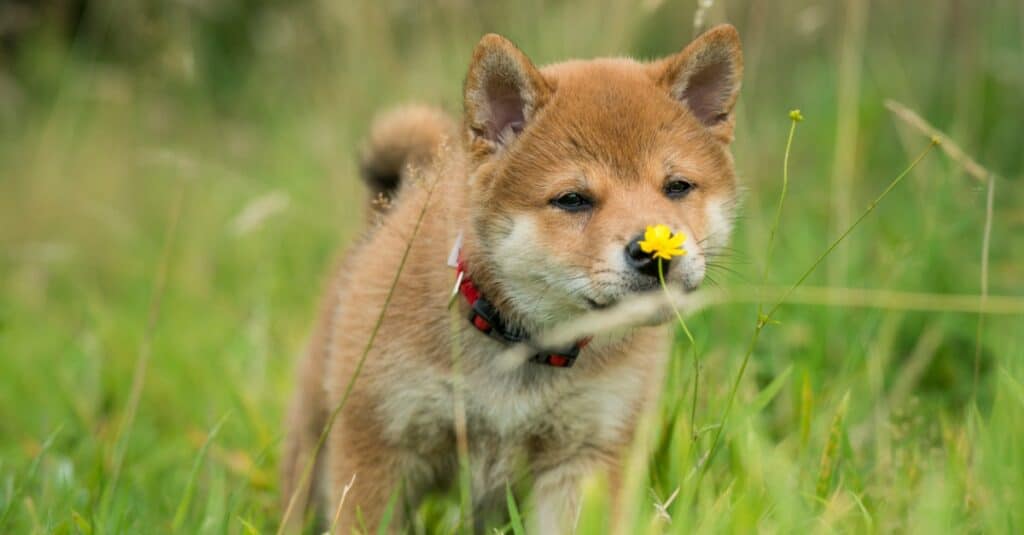
Shiba Inus are bright, loyal, and adaptable. Their ears aren’t quite “right” to look fox-like, but those faces sure are!
©iStock.com/Kurt Pas
Coming from Japan and ranking as the smallest Spitz breed, the Japanese Shiba Inu was originally bred as a hunting dog in ancient times. These alert, bold, confident, loving dogs are easy to train and fantastic with children. The fact that they look a bit like foxes only enhances their charm.
Weighing in between 14 and 24 pounds, at heights between 13 and 17 inches at the shoulder (depending on gender), these small dogs are courageous, loyal creatures that need careful to training to avoid aggression toward strangers. They look similar to foxes with their plush coats and perky ears, as well as their adorable faces. They may come in red, black and tan, sesame, black sesame, or red sesame coloring.
Alaskan Klee Kai
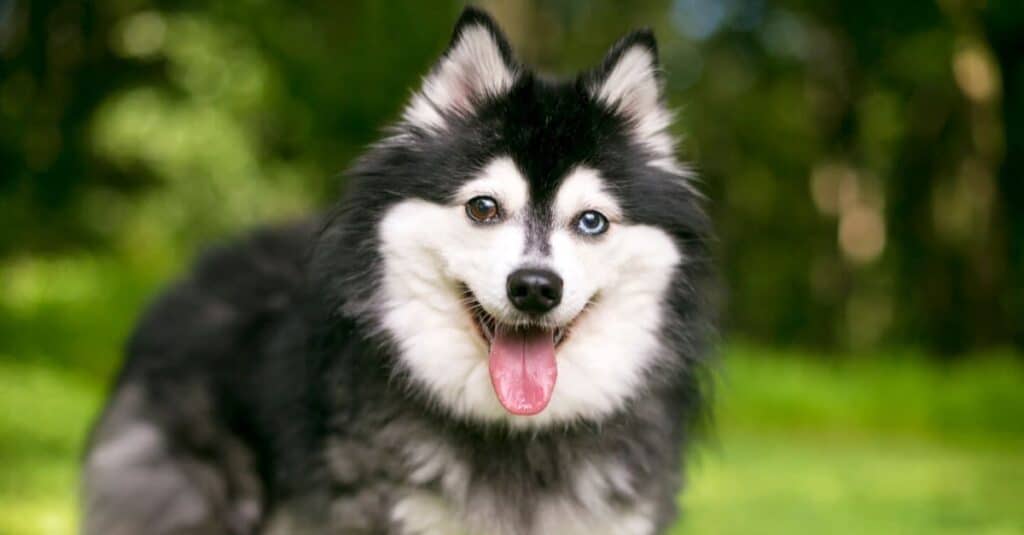
Depending on the breed of fox we’re talking about, the
Alaskan Klee Kai
can look exceptionally like foxes, even with their unusual eyes.
©Mary Swift/Shutterstock.com
Ever dreamed of a Huskie lapdog? Then you’ll adore the Alaskan Klee Kai – a breed specifically designed to be the lap-sized version of the ever-popular dog. The intelligent, playful dogs love families and generally friendly, though they’ll be aloof with strangers in most cases.
These gorgeous dogs that look like foxes love outdoorsy folks and run, run, run all the time. Yet, they are exceptionally well-suited as companion dogs. Continuous training makes these otherwise challenging pooches loveable and companionable.
Alaska Klee Kai comes in many colors, including red and white, all white, black and white, and gray and white, though the red-white combo is rare. This coloration looks particularly similar to the red fox, while the other color combos look more like the marble fox.
Alaskan Klee Kai comes in standard sizes between 15 and 17 inches and 16 to 22 pounds. Lifespan usually ranges between 12 and 16 years.
Indian Spitz

A fluffy white Indian Spitz dog relaxing on a wooden bench, looking a bit like an Arctic fox.
©napat intaroon/Shutterstock.com
Small to medium-sized house pets from Indian, the Indian Spitz is an incredibly intelligent dog breed. The active and alert pooches are naturally healthier than many other breeds, as well, and well-suited to extreme weather found in the heat of India.
They rather look like the German spitz and therefore the arctic fox, with bright eyes, thick coats, and triangular ears. They love their families fiercely, including their family’s kids, but they don’t usually like other pets around.
Indian Spitz comes in white coats and range between 9 and 10 inches at the shoulder. They weigh between 11 and 15 pounds and usually live between 12 and 15 years.
Dhole
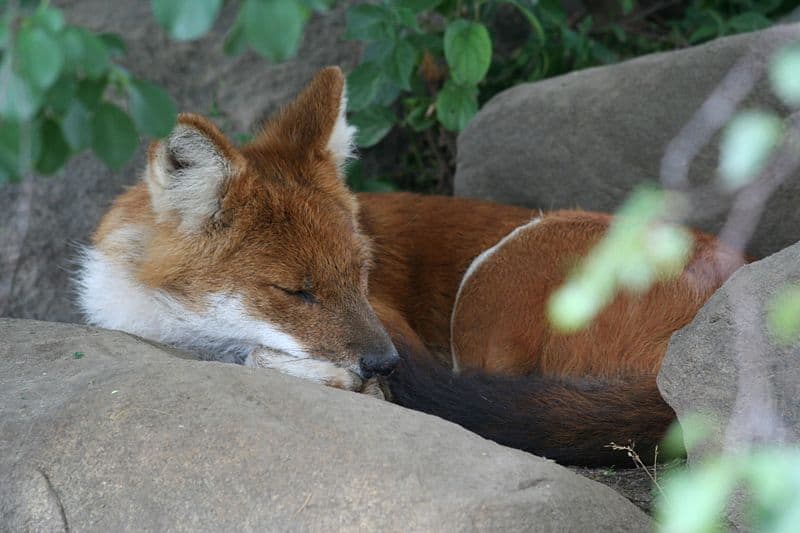
Perhaps the most fox-like of all is the Dhole, the Indian wild dog that is, unfortunately, listed as endangered.
©Ber’Zophus / CC BY-SA 2.5 – License
Also originating in India, the Dhole, or Indian wild dog, ranks as one of the most fox-like dogs around. Known as the red dog or red fox dog, the Dhole looks a lot like the Indian and Arabian foxes, yet does not belong to the same family. They’re also similar to the African wild dog.
The Dhole is not considered a domesticated dog but rather is, unfortunately, an endangered wild dog. It’s been shown that Dhole pups brought up in domesticated situations have been safe around other domesticated animals, but it’s very unlikely they would make good pets as adults. So, unfortunately, these are more beauties to watch from a distance.
Hitting speeds of up to 34 miles per hour and jumping obstacles as tall as seven feet in the air, Dholes have a certain athletic intrigue as well. They’re great swimmers that are social animals in packs of 8 to 12 dogs. The average size of a Dhole is 18 inches and 26 to 44 pounds, with a lifespan of up to 16 years.
Schipperke
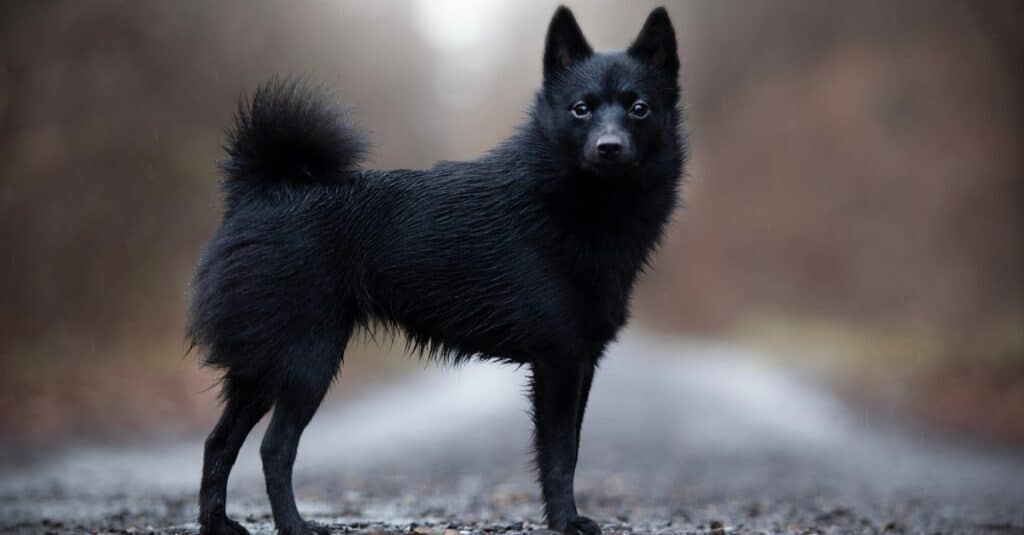
Small Belgian Schipperke dog standing in the woods showing off its fox-like face and form.
©nik174/Shutterstock.com
Looking rather like a small, fluffy black fox, the Belgian Schipperke were once exceptionally popular among ship crews for their knack for catching rats. The name means “little captain” in Flemish. The Schipperke is a bit rarer on this list than some others, but available nonetheless, to folks looking for a companionable fox-like dog.
Standing at approximately 13 inches at the shoulder and weighing in at just 16 pounds or less, the small loyal dogs make excellent guard dogs. They’re fearless, bold, and friendly, and bear cat-like instincts. They love apartment living, though they can be a bit mischievous and definitely need plenty of outdoor play and even more training to keep them well-behaved. They can be prone to barking as well, but generally out of excitement rather than warning.
Schipperkes typically live 12 to 14 years and come with straight, black slightly coarse coats, sometimes with white markings.
Pembroke Welsh Corgi

The happy-looking Pembroke
Welsh Corgi
has the same radiance as the “cunning” fox.
©iStock.com/Tatomm
One of the most popular fox-faced dogs of all is the Pembroke Welsh Corgi – or at least one of the most well-known to be such. The beautiful dogs weigh in at up 30 pounds and only stand about 12 inches at the shoulder, thanks to their short little legs. The friendly, energetic dogs will happily keep you company on long or short walks, looking adorable the whole while.
Pembroke Welsh Corgis have the personality of big dogs packed into a much smaller body, with clever traits, and sensitive spirits. They’re also exceptionally bright and independent, loyal, and loving. Corgis make for superb family dogs, particularly families with kids, and love to play and be silly. And in case you didn’t know, they were actually bred for herding and hunting by the Welsh. They generally live between 12 and 15 years.
Japanese Spitz

Japanese spitz
has the same bright white coat and curious expressions as an Arctic fox.
©joonasp/Shutterstock.com
A highly adventurous breed loving long walks, running, hikes through the forest and even car rides, Japanese Spitz is a popular Arctic fox lookalike. The friendly, quick-to-learn breed grows up to about 15 inches at the shoulder and as much as 25 pounds. With loyalty, intelligence, and cheerful spirits as their hallmark, these dogs are super choices for families.
The records for the history of the breed were destroyed in WWII, but it’s believed that they descended from a cross of German Spitz and Keeshonds from Canada. Both breeds were imported into Japan around the time of the first exhibited Japanese Spitz.
They do well in both countryside homes and apartments and live to be between 10 and 16 years.
Finnish Spitz
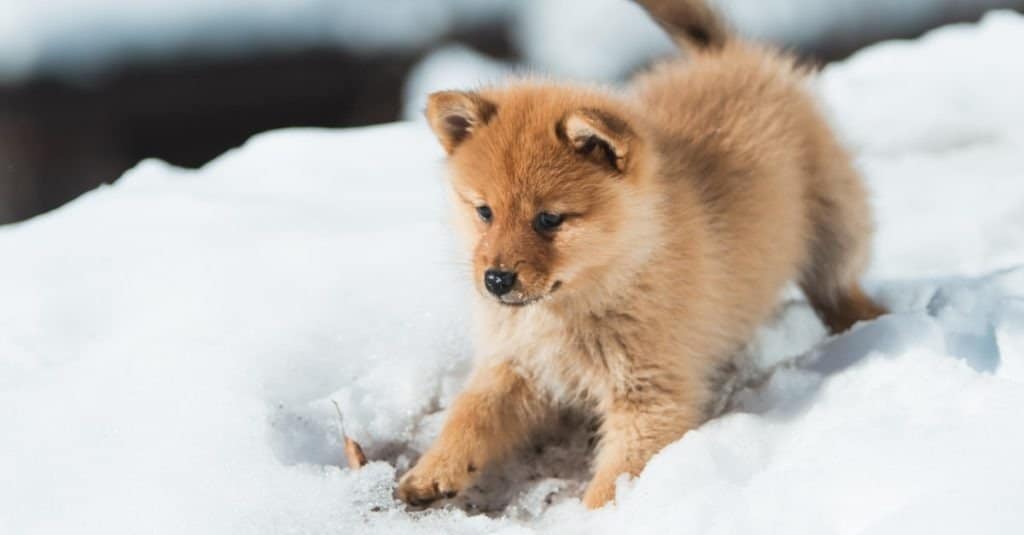
Finnish Spitz puppies have that foxy face and adorable look in particular.
©Sami Takarautio/Shutterstock.com
For a loving companion with a fox-like face, consider the Finnish Spitz. This playful breed thrives in family settings as a medium-sized breed from Finland. They’re out-going, friendly, and have the unique quality of “yodeling” at up to 160 barks per minute that once was used to capturing prey almost hypnotically. They need some training to keep the barking down, of course, but make for amazing companion animals.
Not super common in America, they remain the most popular breed in Finland, particularly for bird hunting. They weigh about 30 to 33 pounds and stand up to 20 inches at the shoulder, and a red-gold double coat. They live a happy lifespan of about 12 to 14 years.
Nova Scotia Duck Tolling Retriever
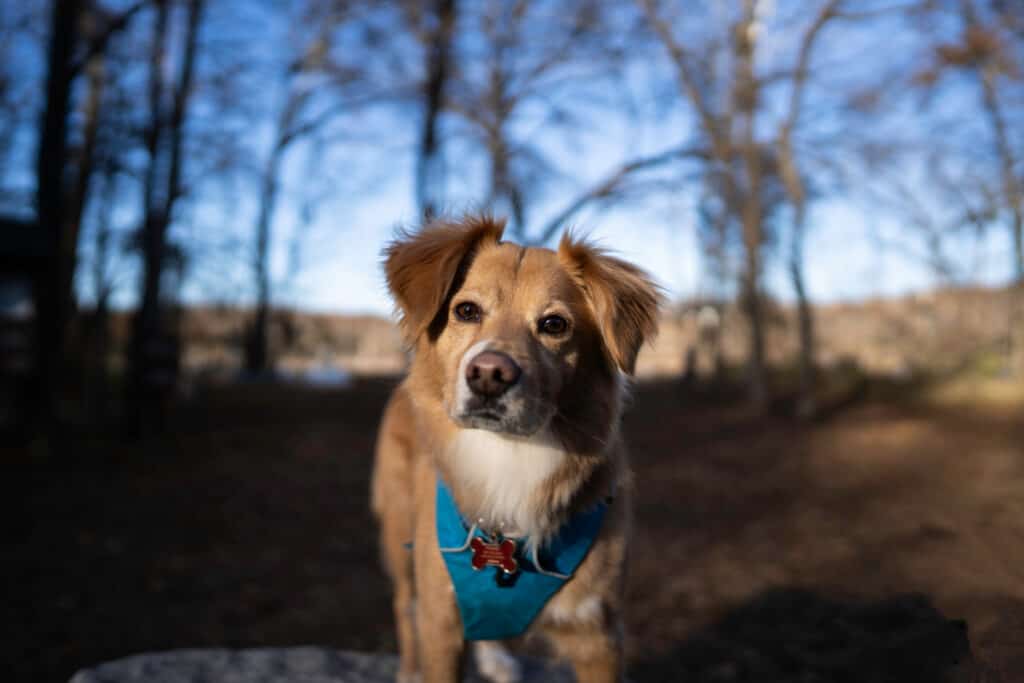
Novia Scotia Duck Tolling Retrievers were designed specifically to “spoof” as foxes.
©Mhughes Photography/Shutterstock.com
With the red fur, white markings, and shapely tails, Novia Scotia Duck Tolling Retrievers were actually carefully bred to specifically look like foxes. Bred for bird hunting, their fox-like appearance was meant to fool birds into thinking they were just everyday forest creatures, not humankind’s best friend.
These pooches stand at about 19 inches at the shoulder, weigh up to 50 pounds, and are exceptionally clever and efficient at their work. They’re also confident, bold, affectionate, loving, energetic, and enthusiastic. Tollers excel at canine sports, hunting, and as working dogs in other fields, but also make for amazing companion animals for active people. They generally live a healthy life of 10 to 14 years.
The photo featured at the top of this post is © iStock.com/Tatomm
Ready to discover the top 10 cutest dog breeds in the entire world?
How about the fastest dogs, the largest dogs and those that are -- quite frankly -- just the kindest dogs on the planet? Each day, AZ Animals sends out lists just like this to our thousands of email subscribers. And the best part? It's FREE. Join today by entering your email below.
Thank you for reading! Have some feedback for us? Contact the AZ Animals editorial team.






